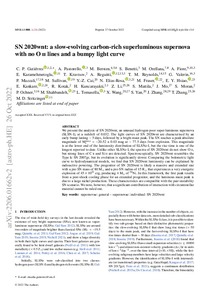SN 2020wnt: a slow-evolving carbon-rich superluminous supernova with no O II lines and a bumpy light curve
Wang X; Kuncarayakti H; Benetti S; Shahbandeh M; Mattila S; Orellana M; Pastorello A; Ochner P; Li Z; Cai YZ; Fraser M; Zhang J; Sullivan M; Kotak R; Zhang T; Hsiao EY; Kravtsov T; Kankare E; Yan S; Gutierrez CP; Stritzinger MD; Mazzali P; Tomasella L; Bersten M; Mo J; Valerin G; Reynolds TM; Moran S; Reguitti A; Karamehmetoglu E; Elias-Rosa N; Fiore A
SN 2020wnt: a slow-evolving carbon-rich superluminous supernova with no O II lines and a bumpy light curve
Wang X
Kuncarayakti H
Benetti S
Shahbandeh M
Mattila S
Orellana M
Pastorello A
Ochner P
Li Z
Cai YZ
Fraser M
Zhang J
Sullivan M
Kotak R
Zhang T
Hsiao EY
Kravtsov T
Kankare E
Yan S
Gutierrez CP
Stritzinger MD
Mazzali P
Tomasella L
Bersten M
Mo J
Valerin G
Reynolds TM
Moran S
Reguitti A
Karamehmetoglu E
Elias-Rosa N
Fiore A
OXFORD UNIV PRESS
Julkaisun pysyvä osoite on:
https://urn.fi/URN:NBN:fi-fe2022112967792
https://urn.fi/URN:NBN:fi-fe2022112967792
Tiivistelmä
We present the analysis of SN 2020wnt, an unusual hydrogen-poor superluminous supernova (SLSN-I), at a redshift of 0.032. The light curves of SN 2020wnt are characterized by an early bump lasting similar to 5 d, followed by a bright main peak. The SN reaches a peak absolute magnitude of M-r(max) = -20.52 +/- 0.03 mag at similar to 77.5 d from explosion. This magnitude is at the lower end of the luminosity distribution of SLSNe-I, but the rise-time is one of the longest reported to date. Unlike other SLSNe-I, the spectra of SN 2020wnt do not show O II, but strong lines of C II and Si II are detected. Spectroscopically, SN 2020wnt resembles the Type Ic SN 2007gr, but its evolution is significantly slower. Comparing the bolometric light curve to hydrodynamical models, we find that SN 2020wnt luminosity can be explained by radioactive powering. The progenitor of SN 2020wnt is likely a massive and extended star with a pre-SN mass of 80 M-circle dot and a pre-SN radius of 15 R-circle dot that experiences a very energetic explosion of 45 x 10(51) erg, producing 4 M-circle dot of Ni-56. In this framework, the first peak results from a post-shock cooling phase for an extended progenitor, and the luminous main peak is due to a large nickel production. These characteristics are compatible with the pair-instability SN scenario. We note, however, that a significant contribution of interaction with circumstellar material cannot be ruled out.
Kokoelmat
- Rinnakkaistallenteet [19207]
